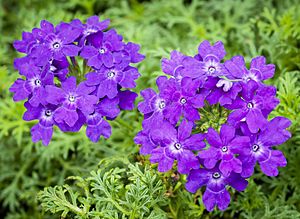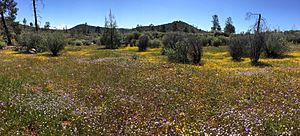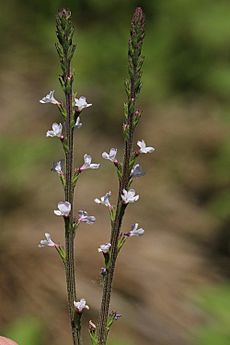Red Hills (Tuolumne County) facts for kids
Quick facts for kids Red Hills |
|
|---|---|
| Highest point | |
| Elevation | 1,750 ft (530 m) |
| Geography | |
| Country | United States |
| State | California |
| County | Tuolumne |
| Range coordinates | 37°50′25.740″N 120°27′28.707″W / 37.84048333°N 120.45797417°W |
| Topo map | USGS Chinese Camp |
The Red Hills are a special group of hills in Tuolumne County, California. They are called "Red Hills" because of the unique reddish soil found there. These hills are not very tall, ranging from about 750 to 1,750 feet above sea level. The sides of the hills can be quite steep.
In 1937, a movie called North of the Rio Grande was filmed in the Red Hills. It starred William Boyd as 'Hopalong Cassidy'. A train even came through the beautiful landscape for the movie!
Contents
Protecting the Red Hills: A Special Place
The Red Hills are so special that a large part of them is protected. This area is called the Red Hills of Tuolumne County Area of Critical Environmental Concern. It is managed by the Bureau of Land Management (BLM). This means the government works to keep the area safe and healthy.
The protected area covers about 7,100 acres, which is a bit more than 11 square miles. You can find it near where two main roads, California State Route 49 and California State Route 120, meet. It's also close to the old town of Chinese Camp, California.
This special protection helps save rare plants and animals. The Red Hills have unusual serpentine soils. This type of soil is important because it helps unique plants grow that can't be found anywhere else. The area also protects a rare type of minnow called the Red Hills roach and is a winter home for bald eagles.
The Geology of Red Hills: How They Formed
The Red Hills are located in a part of California where the Earth's crust has moved a lot over millions of years. The rocks here are very old, from a time called the Upper Jurassic period. These rocks were once part of ancient volcanoes and sediments that were pushed together and changed by huge forces.
A big reason the Red Hills are unique is their soil. Most of the area is made of a special rock called serpentine. This rock is often dark green and can turn reddish when it breaks down, giving the hills their name. Serpentine rock formed deep inside the Earth and was pushed up to the surface. This happened along a major crack in the Earth's crust called the Bear Mountain fault. This fault is like a giant crack that goes very deep into the Earth.
You can also find other interesting rocks in the Red Hills. There are dark brown rocks called dikes that cut through the serpentine. These dikes are long, sometimes over a mile! In some areas, you might also see older rocks like amphibolite and chert. In the lower areas, you can find sand, gravel, and pebbles that have been washed down by water over time.
Plants of the Red Hills: A Unique Garden
The Red Hills are covered mostly by a type of plant community called chaparral/woodland. The most common tree here is the Foothill pine. You won't find many other types of trees. Many different kinds of shrubs grow here too, like Buckbrush, which covers a lot of the area. Other shrubs include Toyon, Coffee berry, Chamise, and Manzanitas.
What's really special about the Red Hills is the grass. Unlike many other places at similar elevations, the Red Hills still have a lot of native perennial grasses. These are grasses that live for many years. This is different from other areas where non-native grasses have taken over. Some important native grasses are California oniongrass and Pine bluegrass.
In the spring, the Red Hills become a colorful display of wildflowers. This attracts many visitors, including students and nature lovers. While many of these wildflowers are common, some are very rare and only grow on the serpentine soil found here.
Sensitive Plants: Rare Treasures

The Red Hills are home to several rare and sensitive plant species. These plants are carefully watched because they are so uncommon. Two of these plants, the California verbena and the Rawhide Hill onion, have been considered for special protection under the Endangered Species Act. This means they are very rare and need help to survive.
- The California verbena is found only in the Red Hills. It grows in small stream areas that stay wet all year round.
- The Rawhide Hill onion has many small groups in the Red Hills. It likes areas with not much other plant growth, especially on sunny, south-facing slopes with shallow soil.
- Layne's butterweed is another rare plant in the Red Hills. It's a member of the sunflower family and is listed as a threatened species. You might find it growing along roadsides or in disturbed areas.
Two other plants, Congdon's lomatium and the Red Hills soaproot, are also locally common in the Red Hills. Congdon's lomatium is only known from the Red Hills and a nearby area called Peoria Valley. The Red Hills soaproot can also be found in El Dorado County, California.
There's also a plant called Chinese Camp brodiaea that grows near the Red Hills on private land. It likes wet soils. Another plant, Hoover's butterweed, grows with the California verbena near streams.
Animals of the Red Hills: Wildlife Habitat
The Red Hills provide a home for many different animals. The shrubs and grasses offer food and shelter for small mammals like mule deer, jackrabbits, and various rodents. You might also spot larger animals like Coyotes, bobcats, and foxes.
Many types of birds live in the Red Hills, with 88 different species observed. Common birds include mourning doves, acorn woodpeckers, and scrub jays. Valley quail and mourning doves are popular game birds here. The area also has many insects, which provide food for insect-eating birds like western kingbirds and tree swallows.
Birds of prey, also known as raptors, can be seen hunting in the Red Hills. These include the red-tailed hawk, Cooper's hawk, prairie falcon, and great horned owl. If you're near water, you might see fish-eating birds like the belted kingfisher and great blue heron. Roadrunners are also found here.
While reptiles and amphibians are not often seen, two rare species live in the Red Hills. The streams and pools are home to fish like green sunfish and large-mouth bass. However, these fish can sometimes compete with or eat the rare Red Hills roach.
Rare Animals: Special Residents
The Red Hills are important for four sensitive animal species. In winter, bald eagles roost (rest) along the shores of Don Pedro Reservoir, especially where Six Bit Gulch meets the lake. Up to 20 bald eagles have been seen here during the colder months.
Even though the Red Hills don't have streams that flow all year, they have many streams that flow sometimes. These streams have pools that stay wet because of underground springs. Two rare animals that live near these wet areas are the California roach (a type of minnow) and the foothill yellow-legged frog.
The Red Hills roach is a special type of minnow found in these permanent pools. During the dry season, these fish stay in the warm, shallow pools. When spring comes, they move upstream to lay their eggs. Scientists have found that the Red Hills roach is unique. It has a special "chisel lip" that it uses to scrape algae off rocks, which is a main part of its diet.
The foothill yellow-legged frog has been found in the western part of the Red Hills. The western pond turtle lives in the eastern part. Both of these are rare species that were once considered for federal protection.
Gold in the Red Hills: A Glimpse into History
The Red Hills area was once a place where people searched for gold. Gold was found in the stream channels, especially in Six Bit Gulch and Poor Man's Gulch. This gold had washed down from areas to the north.
In the past, miners used methods like ground sluicing and hydraulic mining to find gold. Later, in the 1930s and 1940s, large machines called dragline dredges were used. During the California Gold Rush in the 1850s, Chinese laborers worked hard in Six Bit Gulch. They were known for being very patient and thorough. The dredging of Six Bit Gulch and Poor Man's Gulch produced a lot of gold, worth over $100,000 at the time.
Images for kids









